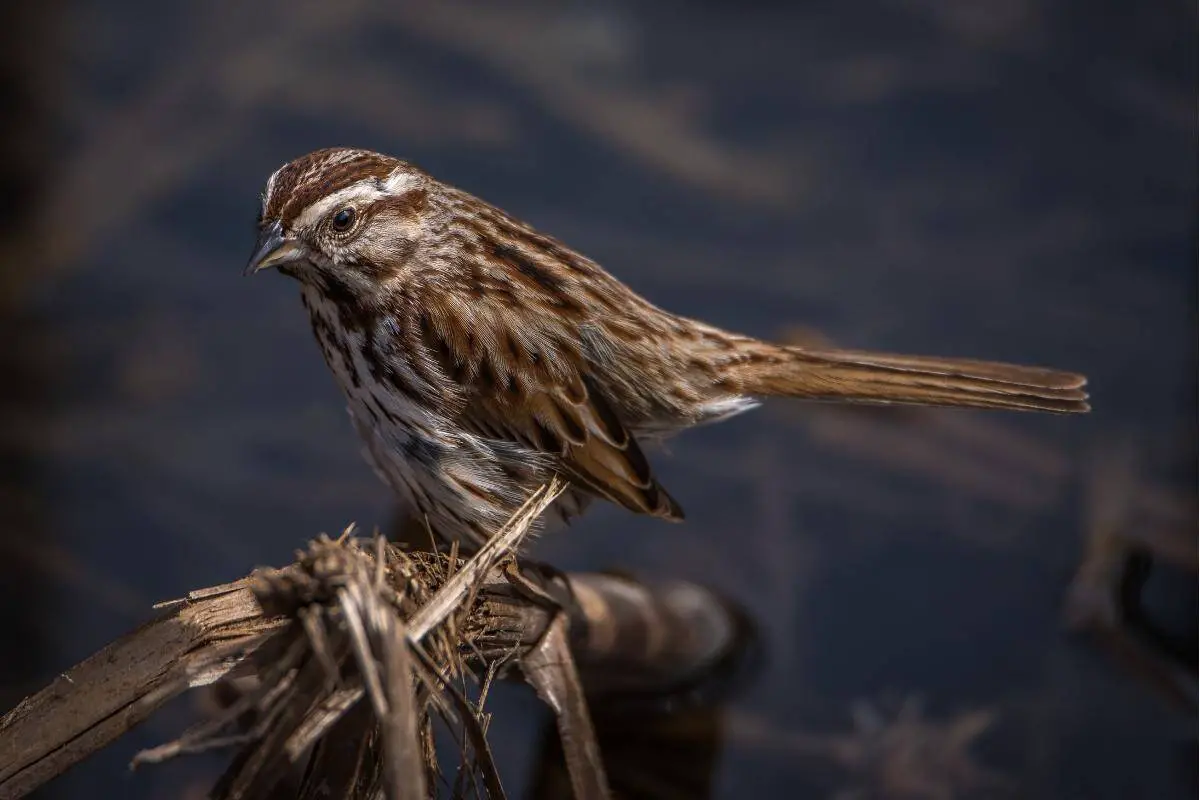
Brown Color Backyard Birds in US
Most small brown backyard visitors are likely to be sparrows, female finches, wrens, or female blackbirds. These birds have numerous hues of brown that might result in a variety of color tints; some have feathers that appear orangish or rufous in color.
While many of the most frequent birds stay in the same place all year, others are seasonal and may appear at various times of the year. Brown-colored backyard birds mainly feed on nuts, berries, and seeds, so having natural plants that provide these foods can help attract more birds.
Table of Contents
What is the Best Way to Identify a Bird in My Backyard?
Using a balanced observational strategy is the easiest way to find out the type of backyard bird. This approach considers the bird’s behavior, sound, color, and field marks. A field guide can also aid in the identification of the most frequent garden birds in your area.
Which Bird Feeder Attracts Most Birds?
Most feeder species, including finches and sparrows, flock to hopper feeders. Many hopper feeders are shaped like houses and have a capped top to keep the seed dry. Birds can settle on and feed on the ledges on the sides of these feeders.
How Can you Tell a Finch From a Sparrow?
A sparrow and a finch can be distinguished by shape and size; a sparrow is a medium-sized bird with short legs, a small beak, and a round head. A finch, on the other hand, has a smaller beak and a flat head. Of the sparrows, the house sparrows are among the most widely distributed species on the globe.
House Sparrow

House Sparrows are distributed all over North America, from Canada’s mid-latitudes south to Mexico. House sparrows were first introduced to North America in New York in the 1850s. Native to Eurasia, they are currently spread throughout the continent, making them among the most familiar birds. These birds have large bodies and short legs.
With a black or gray crown, light-colored abdomen, and brown and black speckled back and wings, the house sparrow is a typical backyard visitor. These sparrows also feature short dark necks, flattened skulls with little in the way of a forehead bump. Males have black collars, rufous napes, and magnificent buff and brown-patterned wings.
The undersides are a delicate pearly gray color. While the females are also streaked, they are lighter and more cushioned throughout, with a paler beak and noticeable buffy eyebrow.
House sparrows tend to avoid densely forested areas. They build their nests in nooks and crevices in buildings, lamp posts, barns, and nest boxes. In rural locations, they may displace native birds from their nests.
These species of sparrows mainly forages while hopping on the ground. Resourceful in their hunt for food, they may collect broken insects from the fronts of parked cars or search for insects on tree wood. They are incredibly tame hence can be fed by hand. Seeds are their preferred food, but they may also consume insects and fruit.
House Sparrows are non-migratory and live in structured, armylike units. The male with the most prominent black spot on his breast is the leader.
Song Sparrow

The Song sparrow is commonly found throughout the United States. This melodic sparrow is widespread in North America, and in areas such as the Northeast and Midwest, it is one of the most well-known species. Migratory species reproduce in northern Canada and winter in southern states and northern Mexico.
The Song sparrow is medium-sized with a rounded tail and a longer body. Primarily streaked brown, this species’ size and coloring vary significantly depending on where they inhabit. The light and rusty variant is found in the southwest, ones with blacker streaks inhabit California, and the overall dusky variant is located in the Pacific Northwest. The face of the Song sparrow is gray, and the throat is white.
The Song sparrow is usually found on the ground under the feeder or clawing in the earth under shrubs to find food. Bird feeders placed near decent cover will attract them. These sparrows also forage in very shallow water, high in trees, and occasionally in bushes. They are known to lurk, hiding in the thickets and only being seen as it darts from bush to bush with its tail thumping. However, their large volumes usually give them away.
The bird’s caterwauling song is also a good indicator of its distinctiveness. In the summer months, these birds use this nearly continual song to attract mates. Males may chase females during courting and execute fluttering flights through the woods with their necks arched and their heads lifted high. The nest, built by the females using grass, leaves, and animal hair, is usually on the ground beneath a clump of grass or shrub.
Fox Sparrow

The Fox Sparrow is a seasonal or wintertime visitor because it breeds in the far north and western mountains. Fox sparrow, a large and chunky sparrow, has two plumage morphs: red and gray. The bird’s name relates to the vivid foxy-red hue of the most eastern and northern populations. The features on the breast and flanks are identical in both morphs, with broad triangular or arrowhead-shaped spots and streaking, a thin eye-ring, and a smear on the face. Both plumage varieties also have a two-toned beak with a darker top mandible.
Fox sparrow has four subspecies: the dark sooty type with heavily streaked breasts in the Pacific Northwest, the thick-billed with gray heads in the California mountains, the Rocky Mountains kind featuring short beaks and gray heads, and the red subspecies found in the eastern US but breeds in Alaska.
Scrubby environments are where you’ll find Fox Sparrows, including brushy gaps in highland and boreal woods in the summer. The Fox sparrows primarily consume seeds and insects. The birds along the coast also eat crustaceans. It is frequently seen on the ground, clawing furiously in the dead leaves with both feet, under impenetrable thickets. Cats and other predators prey on these birds because of this scratching.
American Tree Sparrow
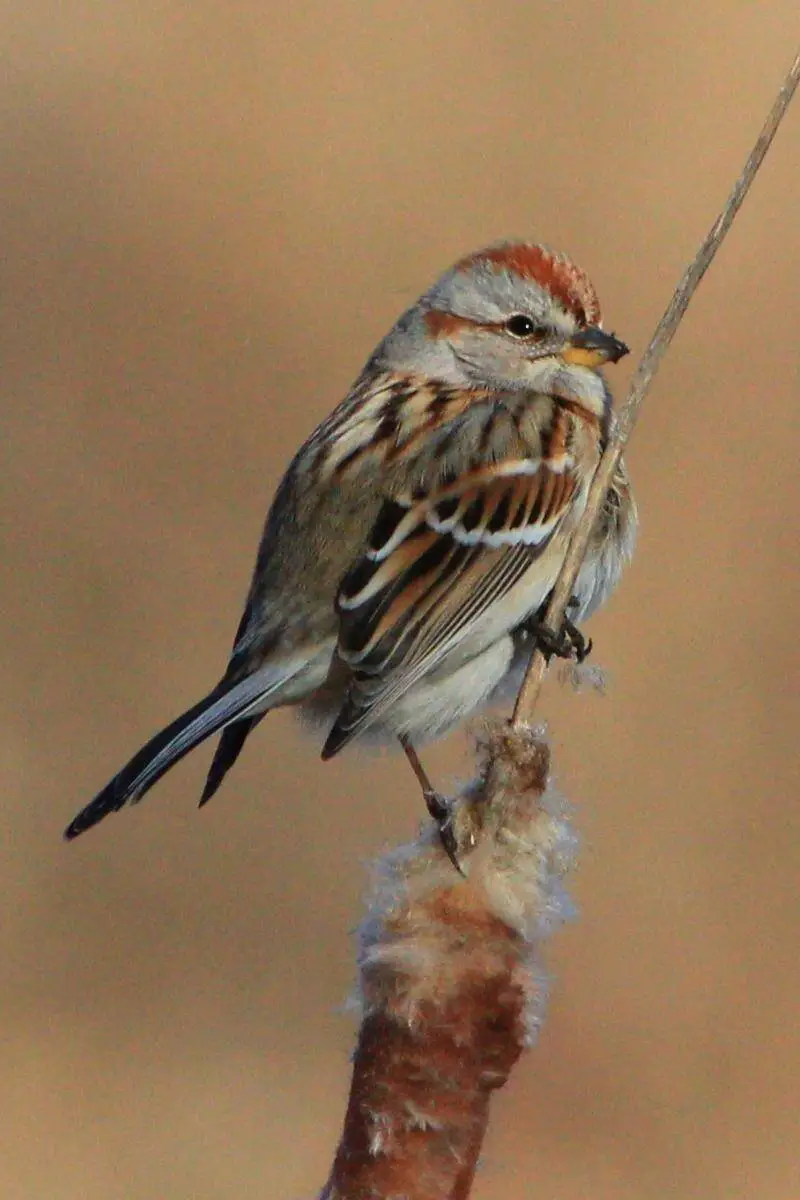
The American Tree sparrow is a small gray bird with a brown back and wings and a darker gray tail. Their round head is light gray, with a rufous crown and a line running back from the eye. On the breast, they have a dark patch.
These sparrows like cooler weather and spend their summertime in northern Canada and Alaska, where they breed. In the United States, American Tree sparrows are wintertime birds that favor grassy or weedy areas near trees in the northern regions. Females typically spend their winters a little further south than males.
These birds migrate at night, during late fall and early spring. As soon as they arrive on breeding grounds in the shrubby tundra, these birds form pairs. The male fiercely guards his territory by scaring away other species members. The nest is usually on or near the ground, in bunches of grass under plants.
The American Tree sparrows are often seen in groups and may mix with other sparrows; they frequently visit bird feeders alongside Dark-eyed Juncos and other species. Small flocks forage for seeds on the ground, creating a delicate, melodic chirp.
White-crowned Sparrow
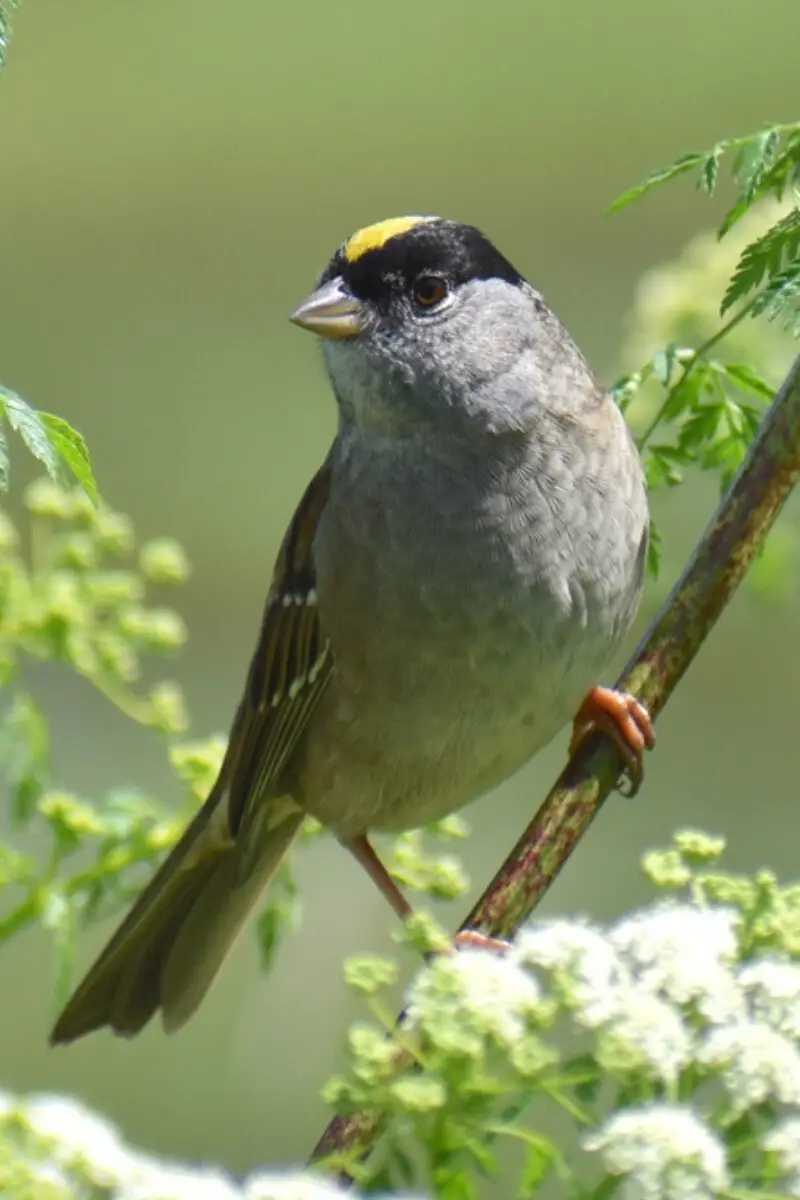
The White-crowned Sparrow is prevalent in the western United States and Canada, although it is less common in the eastern United States. Along the coast, the White-crowned Sparrow is available all year. Summertime is spent in the highlands and north, and winter in the southern plains. These birds rarely migrate to Western Europe.
White-crowned Sparrows have long tails and characteristic thick black and white stripes on adults’ female and male heads, whereas the chicks have brown and tan lines. The underbelly is gray with no spots. The color of the beak ranges from yellow to pink and is always more vibrant than the White-throated Sparrow.
Males, which reach breeding sites before females, defend their territory by singing. In the southernmost coastal populations, pairs may stay united all year in established regions. Like White-throated Sparrows, White-crowned Sparrows breed in the far north in open woodland thickets or brushy environments.
The White-crowned Sparrow forages primarily on the ground while hopping and sprinting. Occasionally, it will eat in low bushes and will take brief flights to grab insects mid-flight. These birds usually forage in groups, except during breeding season.
The White-crowned Sparrows are less common in the yard throughout the winter, choosing to stay in more brushy locations. When they’re in the vicinity, these birds are regular visitors to my feeders. Depending on the feeder type and food choice, these birds are significantly more likely to frequent feeders in the west than the east.
White-throated Sparrow
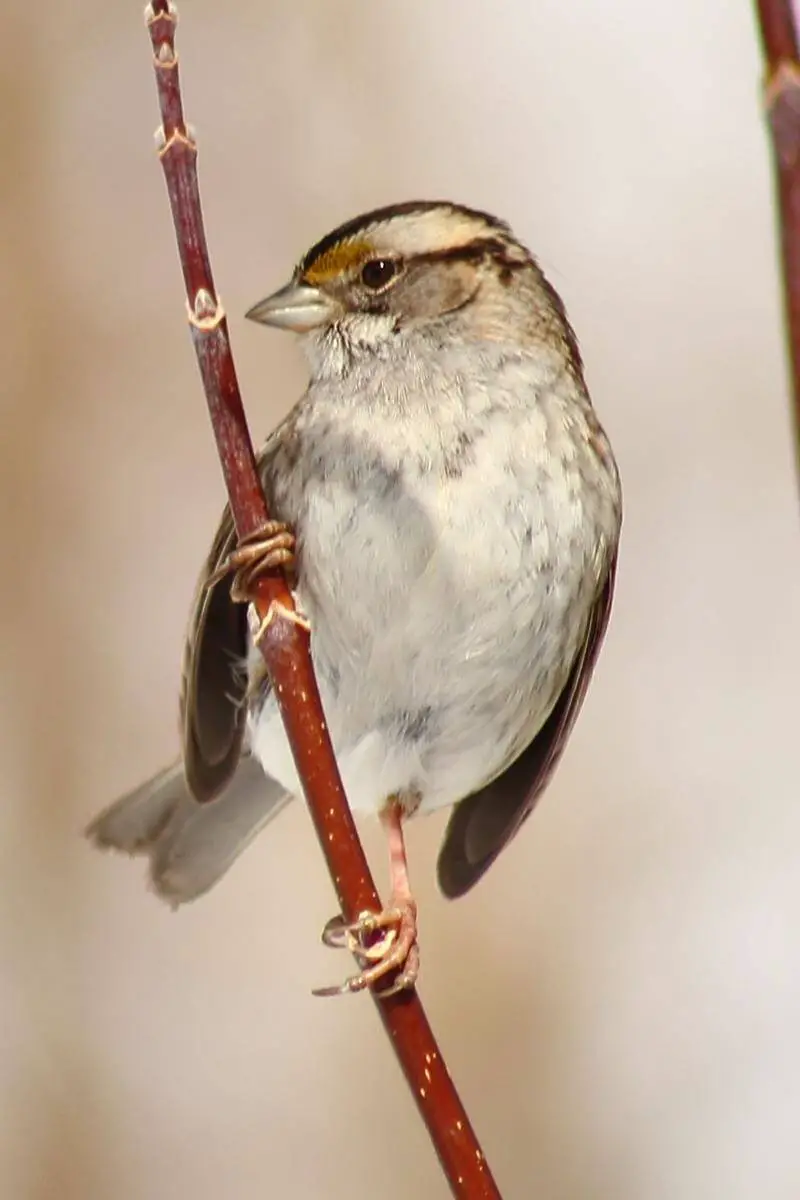
These long-tailed sparrows with large bodies are easily identifiable by their rufous wings and white throat. White-throated Sparrows can be white-striped or tan-striped, with either white or tan bands over their eyes. Both color variants share the unique yellow region in front of the eye. Unlike the White-crowned Sparrow, this bird has a grey beak.
White-throated Sparrows are native to North America. They are migratory birds that nest primarily in Canada before migrating to the Eastern and Southern United States and the Pacific Coast. During the winter, the white-throated sparrow is prevalent in the eastern United States.
In winter, these birds are often seen at garden feeders, drawn by millet and sunflower seeds. They appear to be the most popular of the wintering birds in the yard. It is common to see enormous flocks of birds jump on the ground in gaps near cover to feed. During the summer, they will consume many insects off the forest floor and can be heard chirping their beautiful melodies in northern woodlands.
In coniferous and blended forests where they breed, the White-throated Sparrows build their nests on the ground under shrubs or low in trees.
Golden-crowned Sparrow
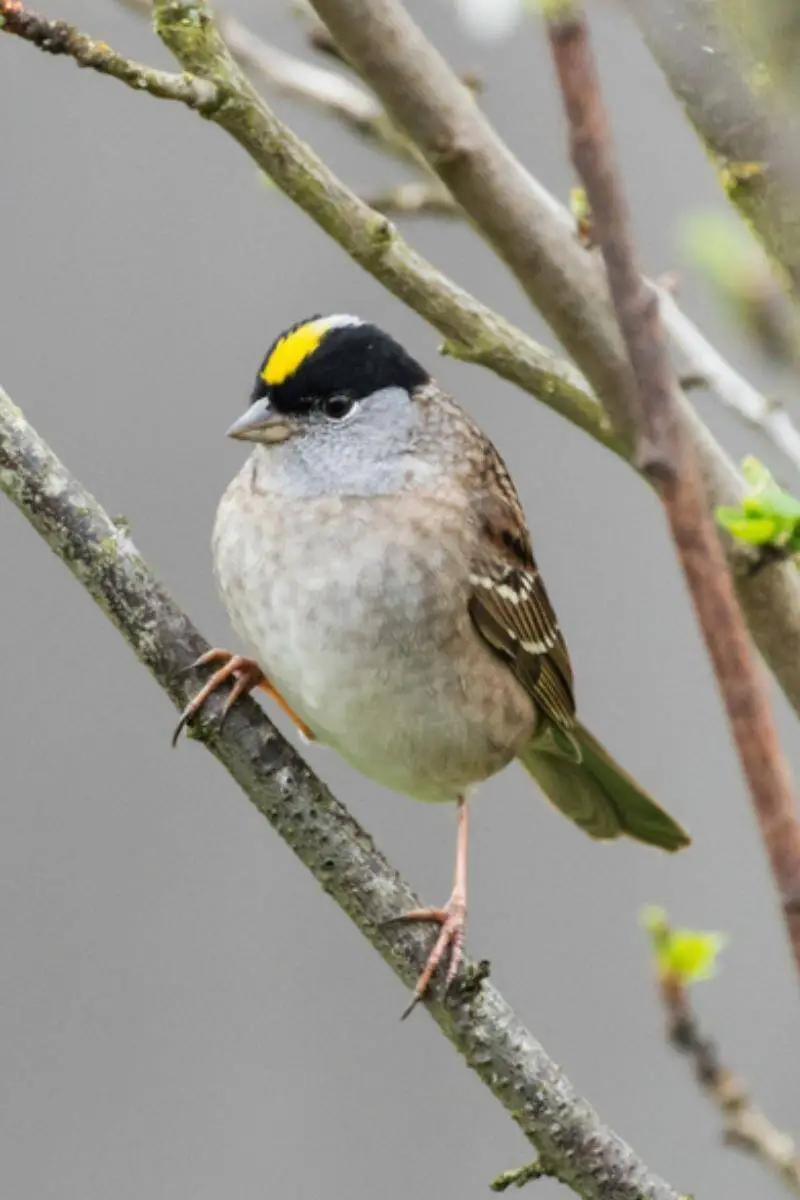
The distinctive gold spot with two adjoining black stripes stretching from their bills to the rear ends of their heads distinguishes golden-crowned sparrows. Spotting a grayish-brown underside and streaked brown back, the golden-crowned sparrow has a more plain, browner face with less contrast, darker underparts, and a dusky bill than the other two species. In the summertime, the spots on adults are more noticeable. In the winter, the patches and the two adjacent black stripes fade.
The golden-crowned sparrows are habitats of North America’s Pacific coast, from the northern shrublands of Alaska and British Columbia to the southernmost reaches of California and Baja Mexico. They are typical winter visitors to the Pacific coast and summer residents along Canada’s Pacific coast and Alaska.
In the winter, these birds can be found on the ground under dense underbrush feeding in groups, often mixed with White-crowned Sparrow. They usually forage in flocks, except while breeding when they can be spotted feeding alone or with their mate. Foraging in flocks in dense vegetation helps keep predators at bay. Their primary food source is insects and seeds, with insects and spiders consumed more in the summer. In the winter, the golden-crowned sparrows mainly feed on weed and grass seeds with other plant materials such as buds, flowers, and newly sprouting shoots. These sparrows can be enticed into the backyard by young seeds in ground feeders or fruit-bearing natural vegetation.
Female Purple Finch
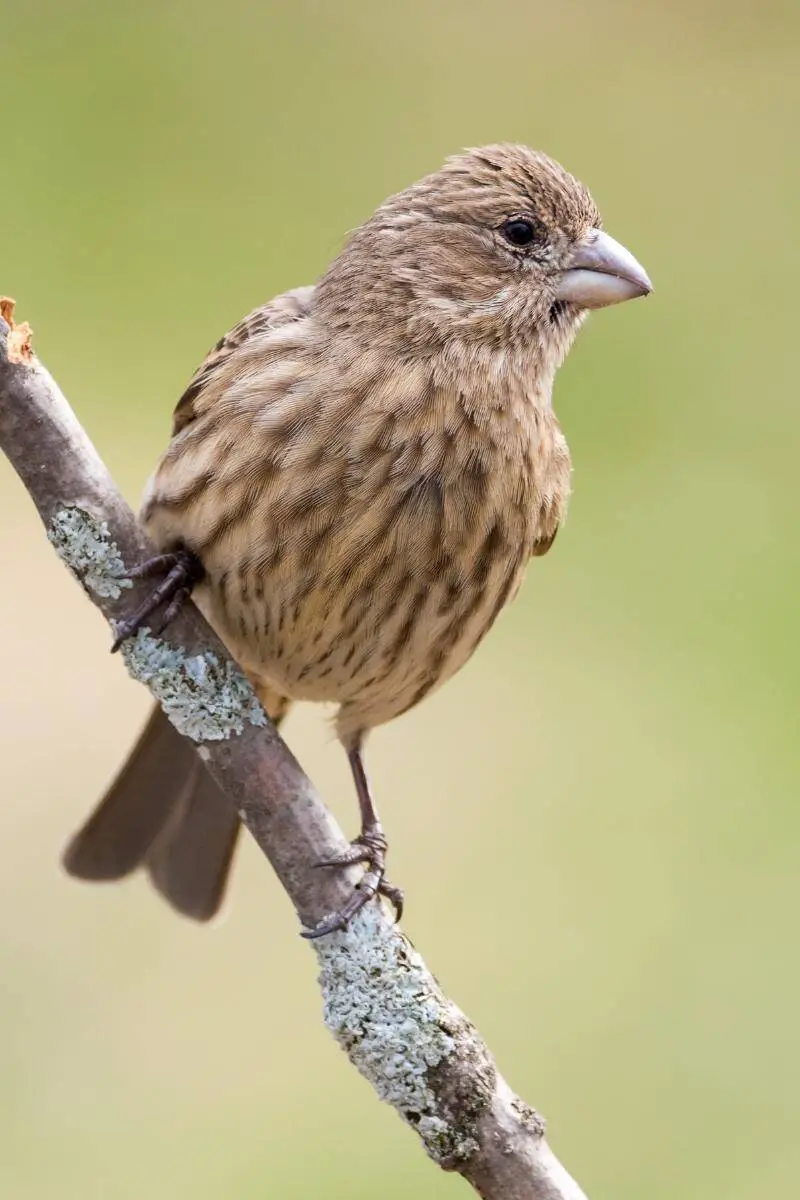
Compared to its body, the Purple finch has a bigger head and a thicker neck, which gives it a stocky appearance. Like other finches, it possesses a sharp cone-shaped bill well-adapted for breaking open seed. Adult females have light brown upperparts and a white rump with dark brown streaks. Pale streaks run through the crown and back.
The purple finch is always hard to be distinguished from the house finch as they both have appealing brown and red plumage (not purple as the name suggests)
The purple finch is common all over the northeast, in Canadian provinces and many regions of the Pacific coast. They usually build their nests on horizontal branches or in tree forks. Although it is a migratory species that breed in northern North America and the West Coast, its range is restricted to North America. Northern Canadian birds migrate to the southern United States, while some remain year-round inhabitants.
Purple finches prefer black oil sunflower seeds over all other seeds. Tube feeders are their preferred method of feeding. However, in the northeast, the purple finch is less common at feeders due to rivalry with introduced House Sparrows and House Finches, which has forced them back into the woods. These birds forage in open forests, both in trees and on the ground.
Female House Finch
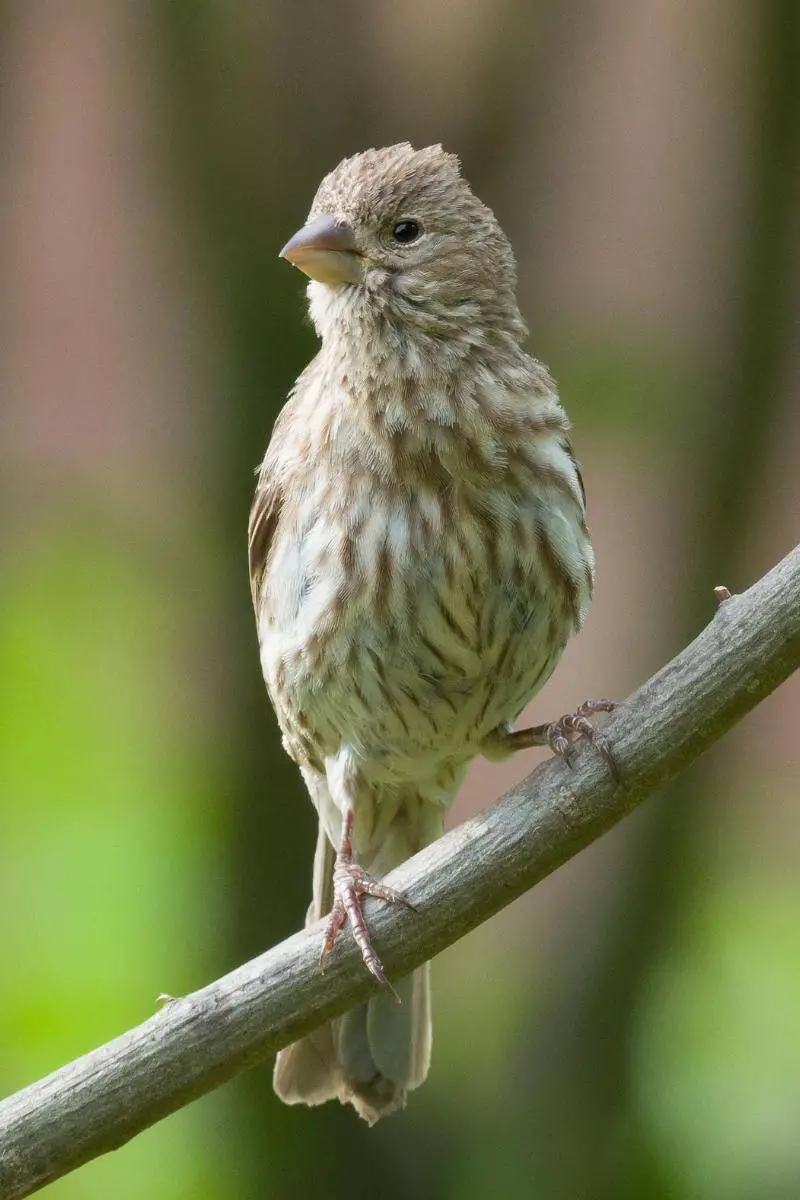
Despite originating in the western United States, the house finch is the most extensively dispersed songbird in North America and frequent backyard birds.
The heads and chests of the House finch are marked by white stripes on females and a bright red spot on the males. Across both genders, the house finch features a conical, gray-brown bill with minor bulbous curves. Depending on the type of berries and fruits that it consumes, the color of the male changes with seasons.
The multicolored males look like the purple finch, and the plainer females resemble a variety of sparrows or finches, making the House finch challenging to differentiate. However, Purple finches have raspberry or wine-red coloration, while house finches have strawberry-red coloration. Additionally, House finches are leaner and have fewer pronounced markings than purple finches, with relatively longer tails.
House Finches forage in foliage or on the ground, eating grains, seeds, and berries. They are also opportunistic consumers of weed seeds like nettle and dandelion and devour small insects like aphids and plant lice. They visit feeders throughout the year, especially those supplied with sunflower or thistle seeds, and will congregate around tube feeders, which they prefer. Nests are built in openings in buildings and on diverse vegetation types by the females using twigs and detritus; on occasion, they will utilize nests deserted by other birds. House Finches can reutilize their nests for consecutive broods or years.
Female Red-winged Blackbird
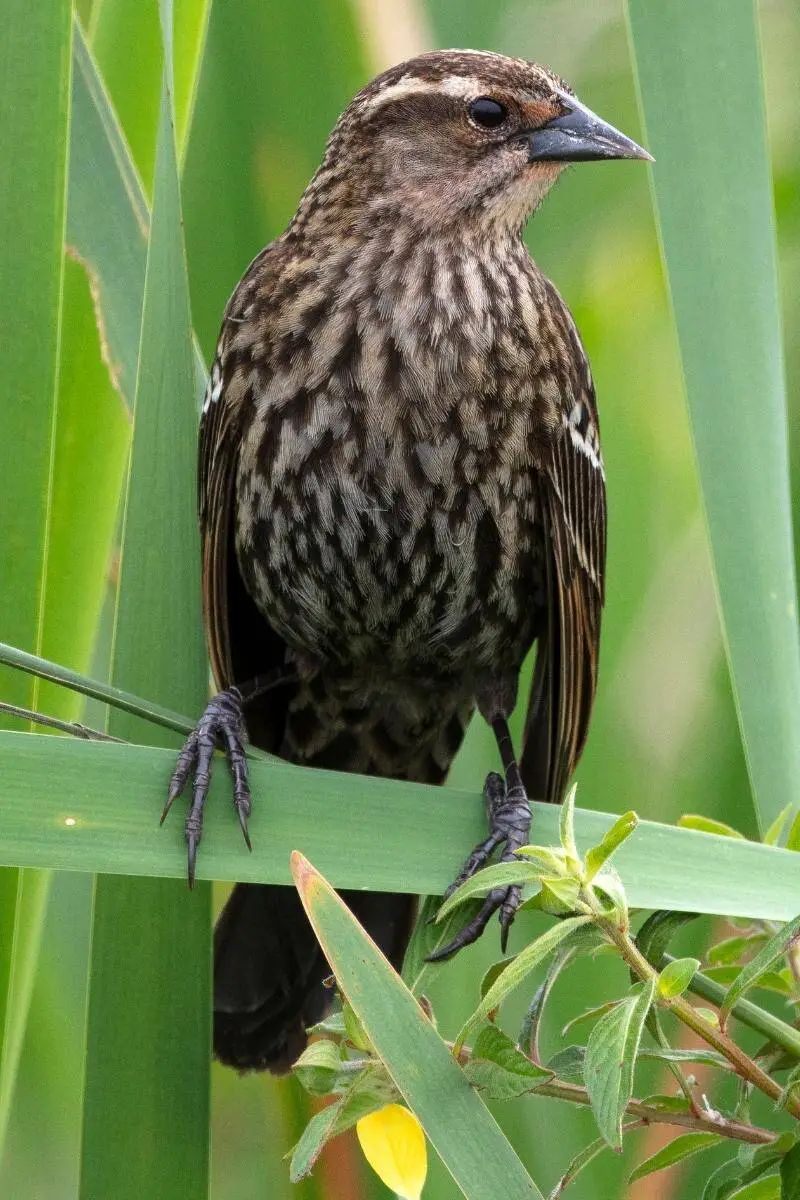
This bird is one of North America’s most widely spread, numerous, and well-known species. Red-winged blackbirds are year-round inhabitants throughout the United States and into Mexico. Red-winged Blackbirds winter in the exact location they inhabit for breeding. The majority of populations in western and central America do not migrate. In the winter, the northern birds travel south to join other permanent birds. During migration, Red-winged Blackbirds may visit backyards in search of mixed grains and seeds.
Males are distinguished by their rich black coloration, highlighted by red and yellow streaks on their wings. The female’s underbelly is extensively and densely striped with dark brown or black. Unlike other sparrows and finches, the intense streaking extends below the tails and does not fade or narrow. A female red-winged blackbird’s face has a pronounced yellowish hue, especially on the lores, chin, and throat. Although the amount of yellow varies, it is an excellent identifier of this bird. Because of their significant similarity to marsh-loving sparrows, female red-winged blackbirds can be challenging to recognize.
Red-winged blackbirds use a range of habitats for nesting and reproducing, but they favor wetlands with plenty of cattails to provide soft nesting material. Females prefer to hide in the marsh plants or grasses. In contrast, the males will sit at the very top of a stalk.
Red-winged Blackbirds feed on most bird seeds, including millet, sunflowers, and cracked corn, in addition to suets. Due to their large size, they favor eating from platform feeders first. Typically, they have better luck foraging on the ground.
Bewick’s Wren
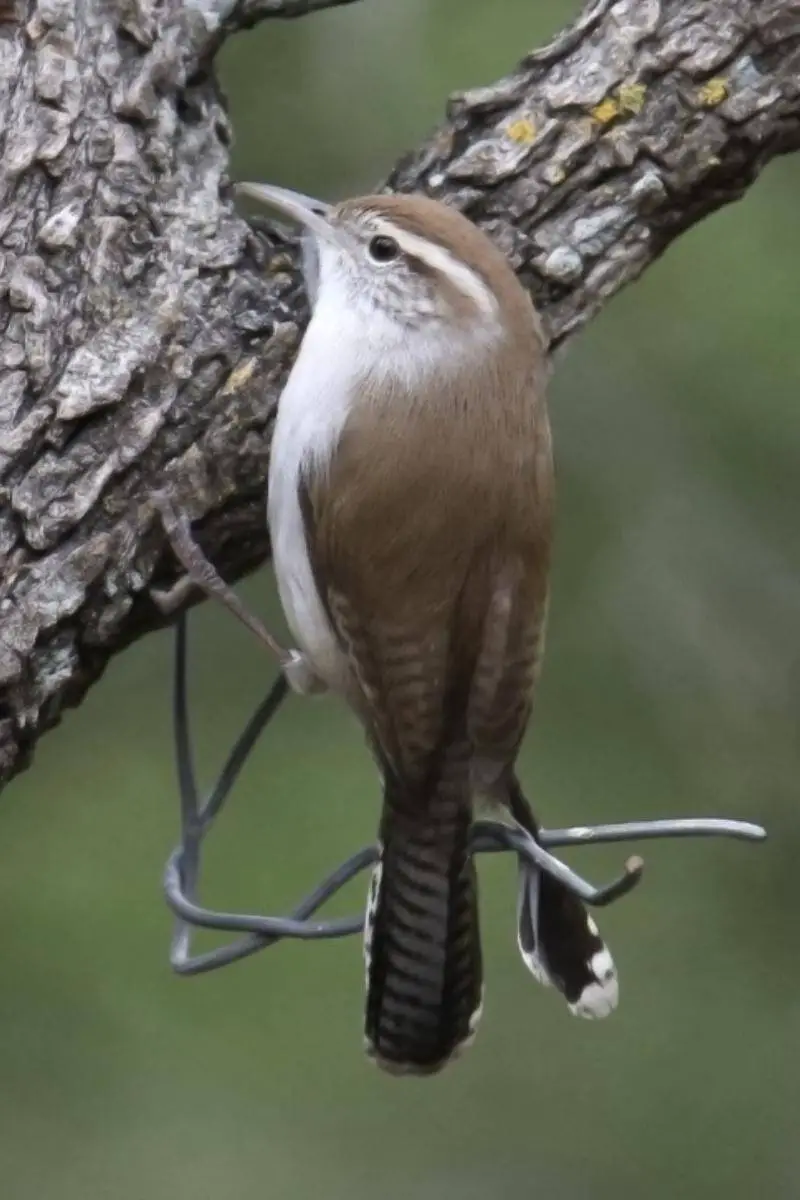
Bewick’s is a slim-built wren with a long tail and a thin bill that is somewhat decurved. The body of this bird is dark brown on top and light grayish on the bottom, with a whitish brow. Although the Bewick’s wren has a wide range of vocal and plumage variations, all adults feature the long tail tipped in white and flipped side to side. Their bellies are gray, and the eyes have a white stripe across them.
Bewick’s Wrens spend the entire year in southern and western states, with only minor migrations in the winter. However, in the east, these birds have all but vanished. These birds favor dry scrubby environments, open forests near rivers and streams, and undergrowth in open country. A Bewick’s wrens can often be found leaping from branch to branch, flipping their long tails in the scrub, thickets, and open forest. They are also at home in gardens, residential areas, and parks.
Wrens are often pleasant visitors to the yard, owing to their wonderful singing. These skilled performers belt out a succession of short whistles, warbles, burrs, and trills to attract partners and protect their homes or reprimand visitors with scratchy sounds.
These birds consume insects and larvae, suet, mealworms, and hulled sunflower seeds found in backyard feeders. They can be attracted to the backyard by gardening with natural shrubs like willow, mesquite, elderberry, and chaparral plants.
Female Brown-headed Cowbird
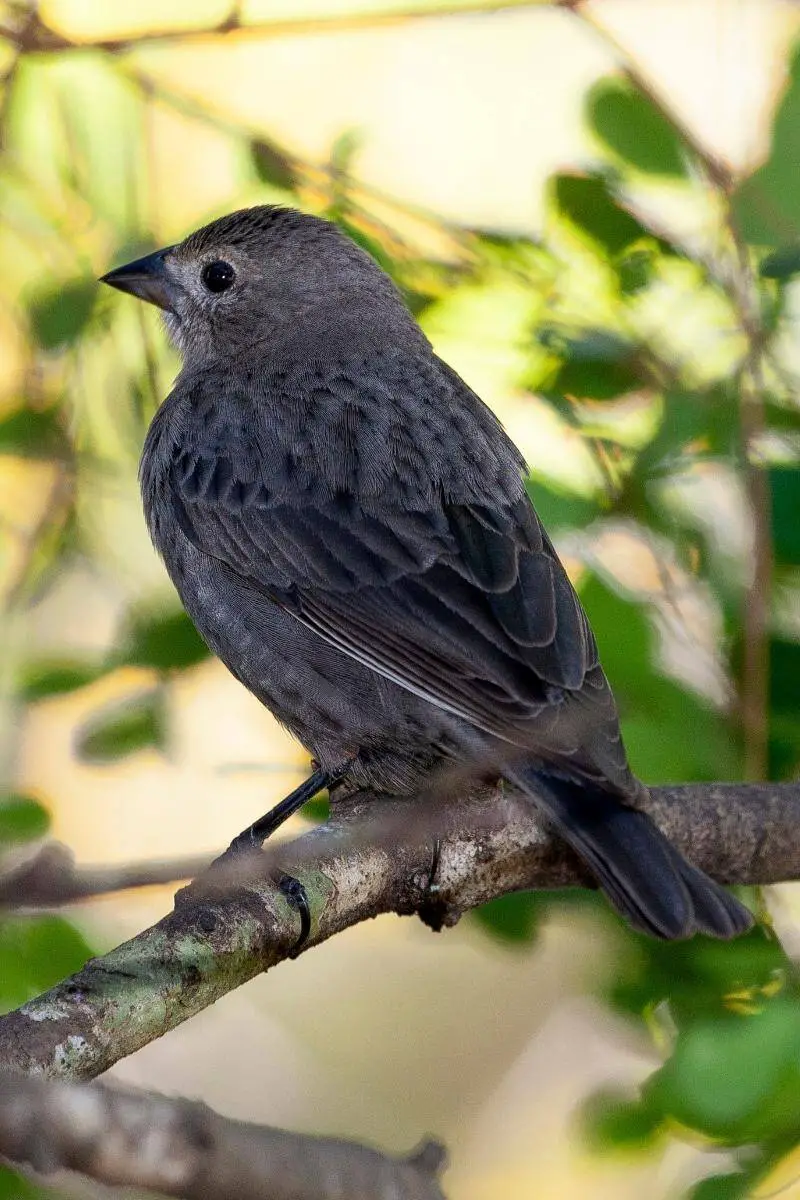
The brown-headed cowbird is a chubby round neck-less bird with a long, slender, slightly curved bill. These birds have three subspecies distinguishable by the shape of their beaks and the length of their wing cords. Female Brown-headed Cowbirds are gray-brown with faint striping all over. Compared to females, males have a larger body that is black with brown heads and short tails.
Cowbirds can be found in open fragmented woodlands, scattered pasturelands, and populated areas. In the Eastern and Southern states and Pacific Coast, these birds remain year-round. These birds breed throughout North America’s north and west before migrating south. Even though they are generally migratory, the scope of their travel varies; some brown-headed cowbirds travel long distances between mating and wintering regions, while others stay close to home. During the winter, they can be found in flocks with other blackbirds.
The brown-headed cowbirds are not monogamous; both males and females have multiple partners in a given season. Female brown-headed cowbirds are in charge of choosing a partner. Males usually woo females by putting on shows and singing from a perch. Female Brown-headed Cowbirds forego building nests in favor of laying eggs in large numbers, occasionally as many as three dozen per summer. Due to their opportunistic habit of depositing eggs in the nests of other birds, the female brown-headed cowbirds are unpopular. They prefer settings that are adjacent to both host nests and foraging places, such as ecotonal habitats. Because they rely on hosts for reproduction, their mating season fluctuates and is modified to correspond with their hosts’ mating season.
Female Brown-headed Cowbirds prefer platform and hopper feeders with large trays as they are ideal for eating millet, their favored grains.

